Reading, singing, physical activity and teaching independence are all important activities that we should be doing with our toddlers daily. In order to improve our children’s chances in life, starting with these activities early on will help them with their early literacy and numeracy skills, help prepare them for formal schooling and above all give you and them some fun bonding time.
Activities I Should Be Doing with my Toddler:
- Reading
- Singing
- Movement
- Sensory Play
- Outdoor Activities
- Teaching independence
- Teaching self-care
Whether you’re a stay at home parent, a family member or friend or a provider in an educational setting, these are all activities that we can do to give our toddlers a fun and educational day.
Toddlers learn through play so provide them with opportunities and stimuli to explore the world around them and allow them to use their imaginations.
Toddlers can only manage activities for short bursts so don’t be disheartened if you provide an activity for them and they only spend a few minutes on it. Save the activity for another day or just leave it out, if safe to do so, and maybe they’ll go back to it later on.
I’ve compiled a list of seven different areas that you can provide activities for every day in order to help your toddler grow and learn. Don’t worry if you don’t manage all seven every day but try to make sure that over a week, you’ve covered all areas.
How should I Include Reading into my Toddler’s Day?
Reading with your toddler can improve your bond together and improve their early literacy skills.
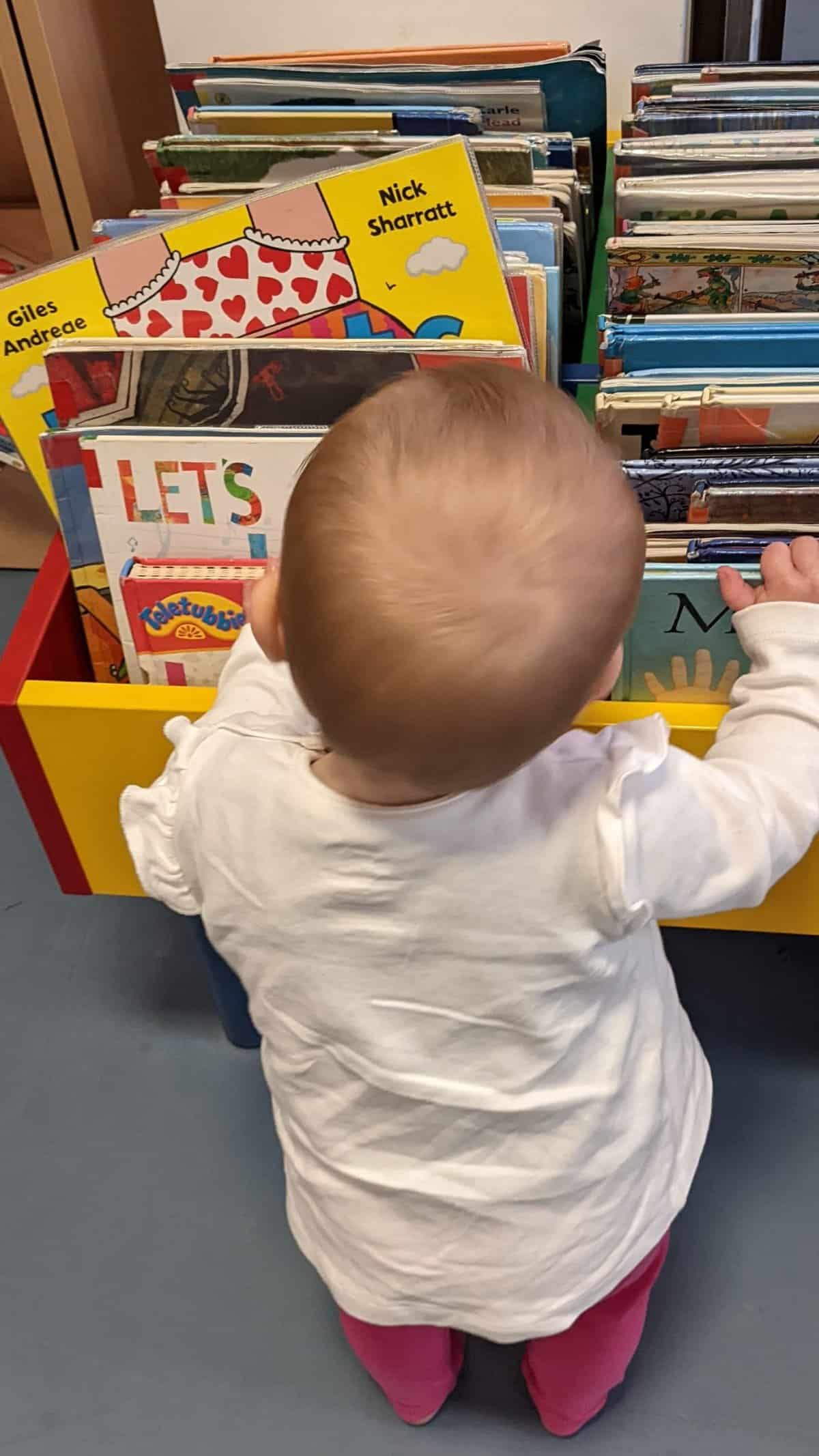
Reading can be done at any time of the day. You could have a bookshelf or box of books within easy reach for your toddler and they could choose to pick books from there throughout the day. Board books would be perfect for this so no pages get ripped. You can also read stories at bedtime. If you read just one story a day with your child from birth to 4 years, your child will have heard 1460 books!
Great books for toddlers are funny, have repetitive lines or rhymes or have tactile pages. We started our children off with the “That’s not my…” range of books when they were babies. Now that our eldest is three, she can have a really good attempt at “reading” the pages because she knows the words which are repeated and can use the tactile pages to help fill in the gaps.
Sit your toddler next to you, on your lap or in their bed and make the story telling as fun as possible. Use different voices and expression as you read. Discuss the story and ask them what they see on the page. Read the same book on several different occasions because toddlers love it when they know what’s going to happen and see whether they can tell you what pictures are on the page.
Visit a local library and let your toddler choose books they’d like to read and take home. Read stories while you are there and then again at home. Find out whether your library runs pre-school story-time sessions as this will help them socialise as well and could involve singing which is another great activity to do with toddlers.
Let toddlers see you reading an actual book. I have to say I do love my Kindle but I’ve recognised that when my daughter sees me on it, all she sees is that I’m watching a screen, not that I’m reading a book (which I usually am!) So, be more obvious about reading, whether it’s an actual book, a magazine or a newspaper. Make them see that it’s a good hobby to choose.
When you’re out and about, see what letters you can spot. Can they see the first letter of their name on anything?
How Should I Include Singing into my Toddler’s Day?
Singing is such a great mood booster. It can also help with early literacy skills much like reading.
Your toddler will expand their vocabulary from singing songs and nursery rhymes. It can teach them about rhyme and rhythm. Number songs are also a great help for recalling and learning numbers.
Our favourite nursery rhymes in our house are:
The Wheels on the Bus
Twinkle Twinkle Little Star
Row, Row, Row your Boat
Humpty Dumpty
Three Little Ducks
Wind the Bobbin up
1, 2,3,4,5, Once I Caught A Fish Alive
I’m Driving in my Car
You can go to a regular stay and play or playgroup where nursery rhymes are sung or you could sing them at home, or both like us.
We have a song bag at home. I printed out pictures linked to the nursery rhymes, then laminated them and put them in the bag. My daughter can then pick a picture out and she knows which song we’ll be singing. It adds a nice randomness to it for me and toddlers like to be included in making choices.
You could also do this with toys in a bag as well. For example a little racing car could be “I’m Driving in my Car!”
What Movement Activities can I get my Toddler to do?
According to the NHS, toddlers should be active for at least 3 hours a day. This can be walking, standing up, rolling around or other more vigorous activities like running, riding a bike and playing ball games.
Find a local park take a kids’ football, a bike and helmet and go and enjoy the fresh air. It’s great to finish with a play on the equipment which can really help their independence. I remember when my daughter first went on a climbing frame without me. It was such a fabulous feeling to see that she was confident enough to climb the steps and go on the slide by herself.
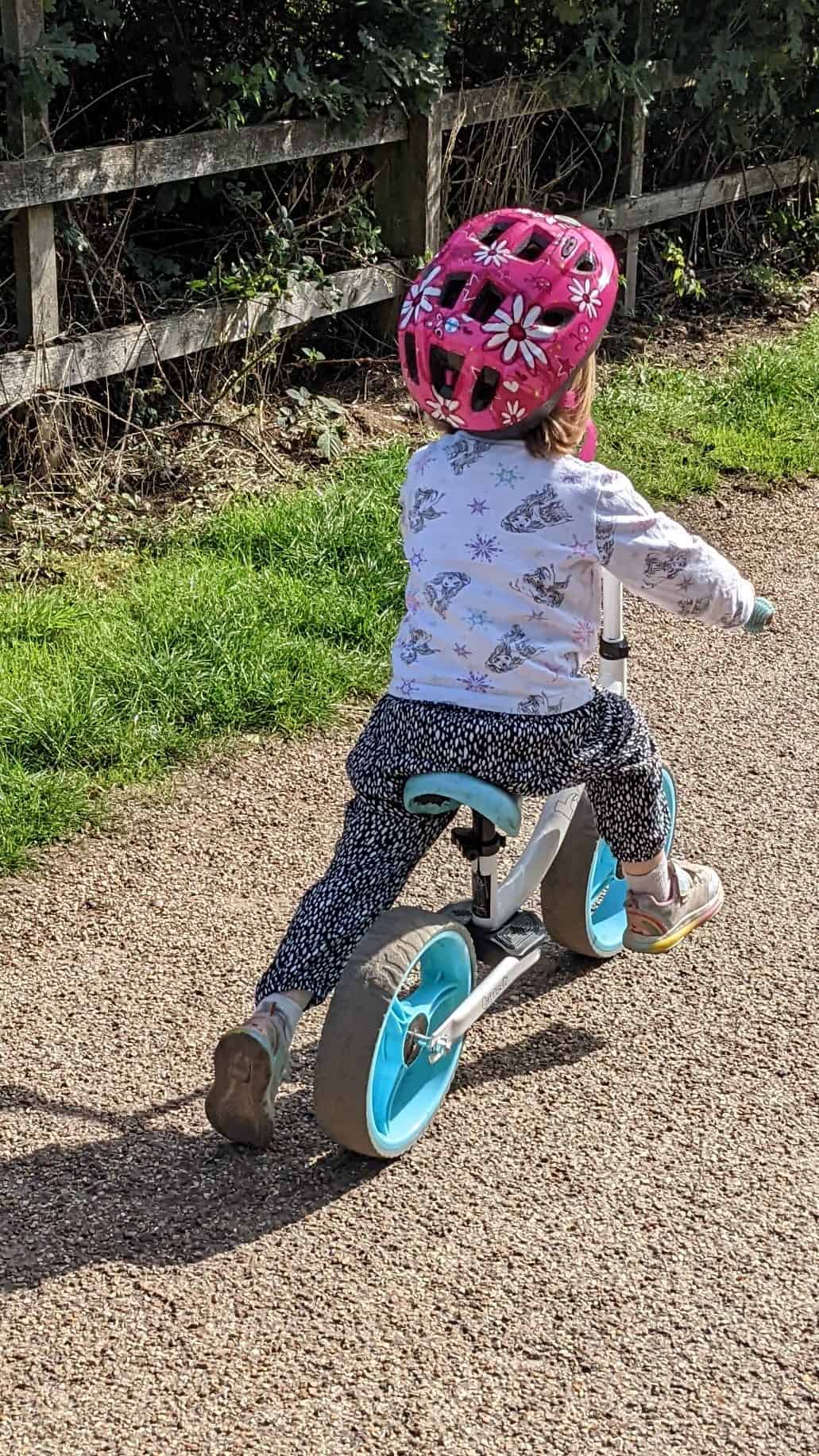
There’s a lovely park near us which has a beautiful flower garden. You park right next to the playground though and it’s so tempting to just go straight on there but I know once we’re in there, we won’t be able to get out. So, what we do is we have a walk or bike ride to the garden and look at their beautiful floral displays, maybe visit the ducks at the lake nearby and then head back to finish off at the playground. This way, our trip to the park is longer and our little one has had much more exercise than if we just went on the playground.
We gave our first daughter a balance bike for her second Christmas and a scooter for her second birthday following that. Our daughter gets to choose whether we take her bike or scooter with us when we go to the park. Both are good exercise for little ones. She has a helmet which she wears when she’s on them as well to keep her little head safe from bumps.
Soft plays are a great place for toddlers to use up all their energy. They also provide a great place for socialising and learning to be independent.
Swimming lessons or public swimming sessions are also a great idea at this time to get your child used to water and begin to teach them about being safe around water.
Try to get your toddler to walk as much as possible rather than putting them in the buggy. Reins can provide a bit of independence for them but also keep them safe and close to you.
What is Sensory Play and How can I Incorporate it into my Toddler’s Day?
Sensory play involves activities revolving around the five senses: sight, hearing, touch, taste and smell and can be so much fun and sometimes very messy!
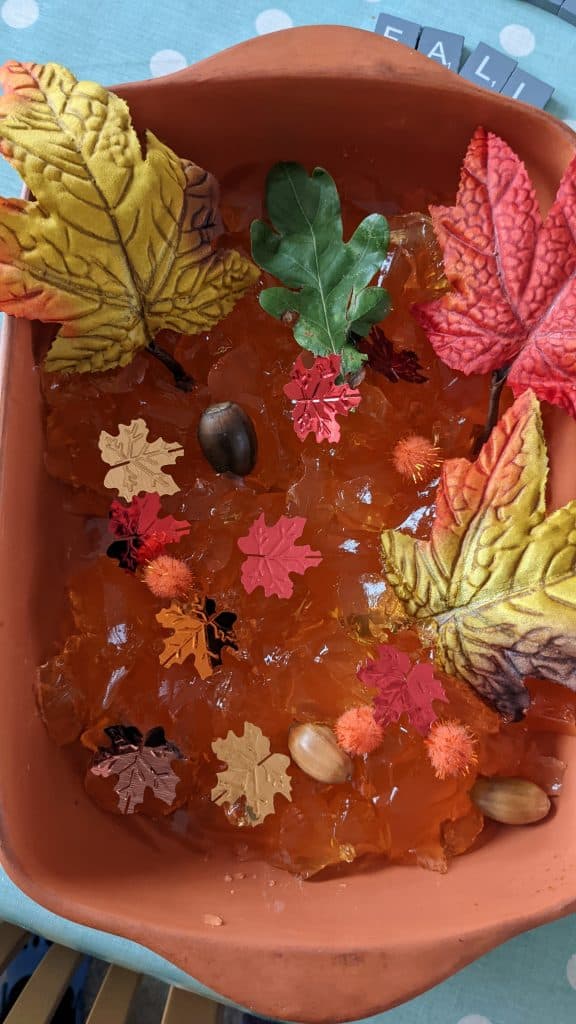
Here are some sensory play activities:
- Go on a listening walk. What sounds can you hear? Are they loud or quiet? Can you make that sound?
- Play i-spy but with colours – “I spy with my little eye, something that is…green.”
- Set big play trays up (sometimes called “Tuff Trays”) with different items in them such as blitzed up cereal, cooked spaghetti, split peas or jelly and let the children use their cars or farm animals to play in the different substances. For this, you’ll need to choose the cereals etc which are appropriate to whether your toddler will eat them while playing or not. My eldest wouldn’t have eaten things on the trays but I know my youngest will so I make sure everything is taste-safe and I watch her like a hawk.
- Water play
- Sand play
- Get some soil and plant up some real or pretend plants.
Eating dinner could also be classed as sensory play if you let your child try to feed themselves.
What Outdoor Activities can I do with my Toddler?
Getting out in the fresh air every day is good for the soul and also for our health. We all need Vitamin D from the sun’s rays to keep our teeth, bones and muscles healthy.
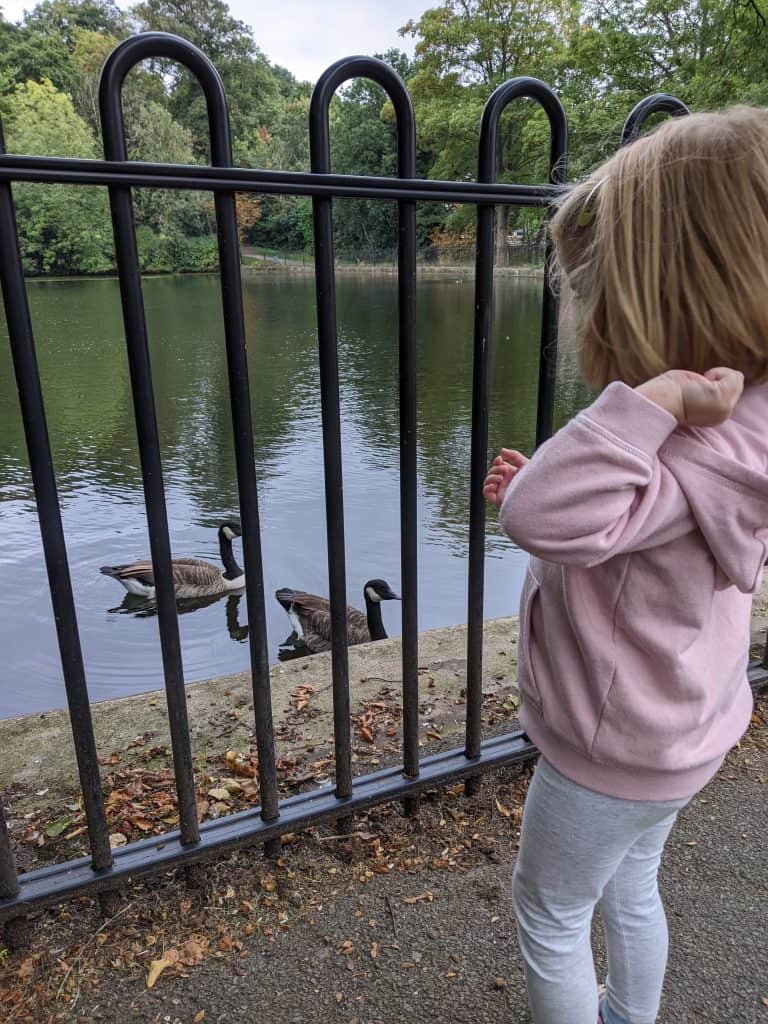
Here are some ideas for outdoor activities:
- Going to the park
- Playing football or other ball game
- Going on a bike/scooter ride
- Going on the school run with older siblings
- Walking to the shops
- Taking a walk round the block
- Playing in the back garden
- Visiting the beach
- Going on a playdate with a friend
- Joining an outdoor playgroup
- Building a fort in the woods
How to Teach Independence to your Toddler
Toddlers love to be able to do things themselves and so we, as parents and caregivers, should give them the opportunity to do as much as possible by themselves or with some support as soon as they show any interest.
This can start with babies wanting to feed themselves or hold their own cup and can move onto them wanting to take their first steps alone.
We can’t just expect toddlers to know how to do something straightaway so there may be lots of little steps of us showing them how to do something, talking to them about it and guiding them through the process. This can sometimes take months depending on the task.
Ideas that I have found useful myself:
- Create a routine e.g. every time that you are going out, sit them down on the stairs and talk to them about putting their shoes on. Have a place where the shoes live so that you can start asking your toddler to go and get their shoes or put them back in their basket.
- When buying clothing for your toddlers, think about the practicalities. Are laces on shoes going to create an independent child? No. Start off with Velcro fastenings for shoes and trainers and make sure they are easy to slip on or off. Also think about clothing choices for potty training. Some items of clothing look so cute but are going to make it really difficult for your little one to get their own clothes off to use the potty. Just think, playsuit?! Your child’s Nursery teacher will also thank you for this!
- Include your toddler in helping around the house. Can they fold the clean laundry with you? How about putting some shopping away? Using a brush to sweep up the crumbs after dinner? Taking their plate over to the sink after lunch? Choose age appropriate tasks, make them fun and don’t stress about whether it’s done properly. Perhaps buy them a child-sized broom for sweeping or a learning tower to help them reach the countertops.
How to Teach Self-Care to Toddlers
Teaching your child to make healthy choices for their body is so important. This can be about the food that they eat, the exercise that they take or how they make sure their bodies are clean.
Here are some activities you can do with your toddler to teach them to practise self-care:
- Teeth brushing
As soon as you can, have your baby watching you brush your teeth, even before they have their own. Then, when they get their first teeth, hand them a toothbrush with baby toothpaste on and let them have a go. They will want to copy you.
Both our daughters are great at brushing their teeth because we don’t stress about it. We have a 2 minute timer from Youtube on to make sure enough time is spent and we sing a silly made up toothbrushing song to remind them to brush the top and the bottom, the back and the front – there’s some great ones on Youtube.
The toothbrushes are stored in a low-down cupboard in the bathroom so when it’s time to brush their teeth, they can get their brushes themselves.
Yes, we have days where it’s not plain sailing but on the whole, they brush their teeth well and have been commended by the dentist.
Book a dentist appointment as soon as they get teeth so they become accustomed to visiting the dentist too.
- Hair brushing
When you have time, give them the brush or comb to have a go. Let them play with dolls and give them brushes and combs so they can practise on them too.
- Bathing
When in the bath, let them put their shower gel on or use a flannel to wash themselves.
- Clothing
Give them two choices of what they want to wear that day. Talk them through how to put each item of clothing on every day as you help them and at some point, they’ll want to help or try to do it themselves.
- Controlling their emotions
We all get angry sometimes and toddlers find it tricky to control their emotions. We can try to help them early on by talking to them about what is the best course of action when they are feeling angry. You could provide them with a quiet corner where they could go and read a book or look at some pictures on the wall. Anytime that you spot that they are getting to that stage, you can remind them about the quiet place or a certain toy that they like and try to divert them away from getting worked up. Distraction also work well too!
- Making healthy choices with food
Toddlers like to be in charge. They like to make the rules but when it comes to food, usually, if there’s a chocolate bar or an apple, they’re going to choose the chocolate bar. So, to make them feel like they still have a choice, offer them an apple or a banana. They still get a choice, it’s just that neither of them is an unhealthy choice. Chocolate bars are ok in moderation but aren’t great for kids’ teeth with the amount of sugar in them.
- Making healthy choices around activities
This is about us as parents and caregivers providing opportunities to get away from the TV or tablet and show our children that there is so much to do in our world. Be that reading a book, getting outside for some fresh air or building a tower. What happens if I knock it over?
TV and tablet time is fine but again in moderation.
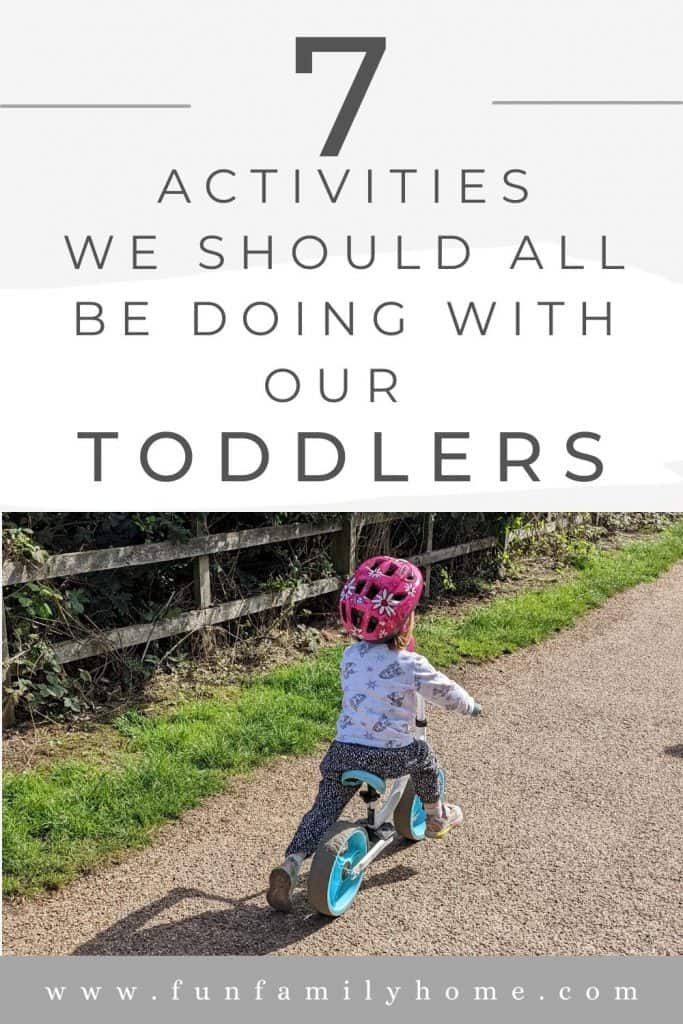
What are the Benefits of Doing These Seven activities with my Toddler?
Carrying out these seven activities with your toddler every day will help prepare them better for school and for the big, wide world. It will improve their literacy skills, their counting, and teach them independence. But above all, it will provide them with a fun start to their lives.

Useful links:
NHS: Physical activity guidelines for children (under 5 years) – NHS (www.nhs.uk)
CDC: Toddlers (1-2 years old) | CDC NHS: Vitamin D – NHS (www.nhs.uk)
Recent Posts
Introduce your toddler to other religions and cultures with these fun activities.
10 Fun & Easy Autumn Leaf Activities for Toddlers and Young Children
Find ideas for entertaining toddlers and preschoolers this autumn.

